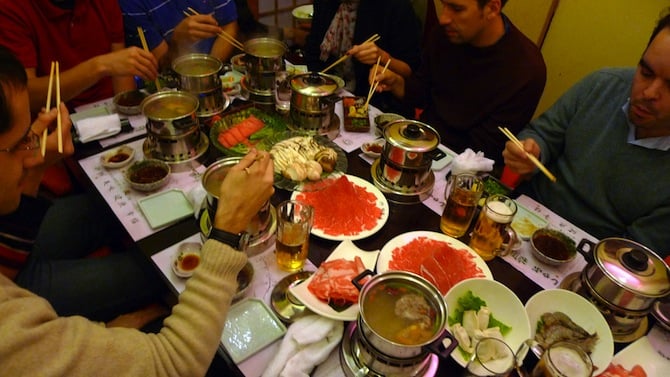
One of the most interesting restaurants I ate at during my trip to Kyoto, Japan, was at Gion Gyuzen (323 Gionmachikitagawa, Higashiyamaku) and partaking in some traditional shabushabu. Upon entering the restaurant I was asked to remove my shoes and was escorted to a private room with sliding doors and a low table adorned with two potable hot clay pots filled with water flavored with seaweed. Pretty soon, plates of Kobe beef, pork, octopus, jellyfish, Japanese pumpkin, prawns, crab, scallops, sweet potatoes, enoki mushrooms, sprouts, konnyaku (glass noodles), Chinese cabbage, onion and more were brought in an unlimited fashion for myself and my dinner companions to cook ourselves in a hot pot. It’s particularly fun saying “shabushabu” quickly, over and over, until your food is ready to be smothered in your ponzu and sesame seed sauces and eaten.
For a quick bit of history, the name shabushabu was introduced by a restaurant in Osaka called Suehiro. They trademarked the name in 1955. That being said, actual shabushabu — just not called so — has hot pot origins, thought to come from Mongolia over 1,000 years ago. Today, shabushabu is one of Japan’s most popular dishes for both locals and tourists.
Tip: Save room dessert. The restaurant serves a decadent banana crepe stuffed with vanilla ice cream and thick whipped cream and topped with chocolate and caramel sauces.
What’s your favorite Japanese dining experience? Please share in the comments below.
My trip to Japan’s Kansai Region was sponsored by the Japan National Tourism Organization. I was not required to write this post nor was I compensated for it. All opinions are 100% my own.
Top photo credit: Shabushabu. Photo courtesy of Drew Bates.

Jessica Festa is the editor of the travel sites Jessie on a Journey (http://jessieonajourney.com) and Epicure & Culture (http://epicureandculture.com). Along with blogging at We Blog The World, her byline has appeared in publications like Huffington Post, Gadling, Fodor’s, Travel + Escape, Matador, Viator, The Culture-Ist and many others. After getting her BA/MA in Communication from the State University of New York at Albany, she realized she wasn’t really to stop backpacking and made travel her full time job. Some of her most memorable experiences include studying abroad in Sydney, teaching English in Thailand, doing orphanage work in Ghana, hiking her way through South America and traveling solo through Europe. She has a passion for backpacking, adventure, hiking, wine and getting off the beaten path.








